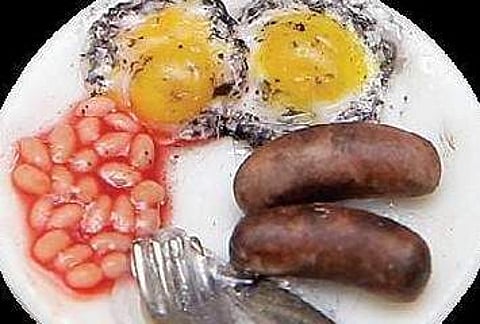Fabulous feat of miniscule clay
Rupashree Adam is a Masterchef. From idli-sambar, full south Indian meals and biryani to an English breakfast and Japanese sushi, she can whip up any dish. But you can’t eat any of it, because her preparations are miniature replicas made from polymer clay.
As a child, Rupashree’s mother would hand her small balls of chapati dough to play with, while she prepared dinner. Just like children her age, Rupashree would try to make objects with the dough, replicating anything that caught her wandering eyes.
Rupashree—who lives in Chennai—did not grow out of this “hobby”. As a first year visual fine arts student, she revisited her childhood pastime three years ago. This time, she replaced chapati dough with polymer clay. The revival was inspired by miniature food replicas that Rupashree saw in Europe while on a vacation five years ago. Upon her return, Rupashree began researching methods and processes, and finally settled on using polymer clay to sculpt her creations.
Rupashree has a diverse menu, though her focus is creating replicas of south Indian delicacies. “I have seem many Indian creators making a wide variety of miniatures, but none making south Indian food items, so I decided to explore this cuisine,” she says.
As a full-time undergraduate programme student in Chennai, Rupashree did not find time to make her miniatures during the day. So she would spend a couple of nights a week sculpting them.
Making each of these tiny dishes demands skills that are more refined and accurate than those in a kitchen. It takes Rupashree one to four hours to sculpt her miniatures. “Making dishes like biryani are the toughest. I need to roll out every grain of rice. All the grains must look uniform. The pieces of lamb must also look authentic, it is tough to achieve that. Getting the perfect colour and texture takes a lot of time and effort,” she says.
Once Rupashree sculpts her pieces, it is time to bake them in a small preheated toaster oven. “Two minutes,” she says, looking at her watch. This time it is not a quick cup of two-minute noodles, it is a plate of two-minute sambar vada. A couple of seconds more and it could be charred. Rupashree turns the oven off prematurely. “That should be enough,” she says. She couldn’t be more right. A few seconds more would have cost her dear: 90 minutes of sculpting wasted.
Rupashree has ‘burnt’ only one project—a Starbucks milkshake. “It took me three hours to sculpt it and get the colours right,” she says. She was so saddened by the failure that she has not attempted another Starbucks project.
She takes custom orders and prepares any ‘dish’ her clients want. People also want to learn to make polymer clay food miniature designs from her. “I had no idea it would become this big,” she confesses.
Most of her clients want the miniatures to be either turned into fridge magnets or put in an acrylic box as gifts. She now has a new range of miniatures planned for Christmas.
Rupashree has now also begun offering one-day workshops on making miniature food replicas with group classes and one-on-one sessions. “I am only teaching basics and making simple food like idli-sambar,” she says. Rupashree has also created tutorial videos to help anyone who wishes to learn making miniature food replicas. The videos will soon be up on YouTube, her website charmingminiatures.com and her Facebook page, Charming Miniatures.
Rupashree will soon be joining a culinary programme, Le Cordon Bleu, in New Zealand. She won’t be making vadas or biryani for the first nine months, but will be part of patisserie course, following which she will participate in a full-fledged culinary course.

